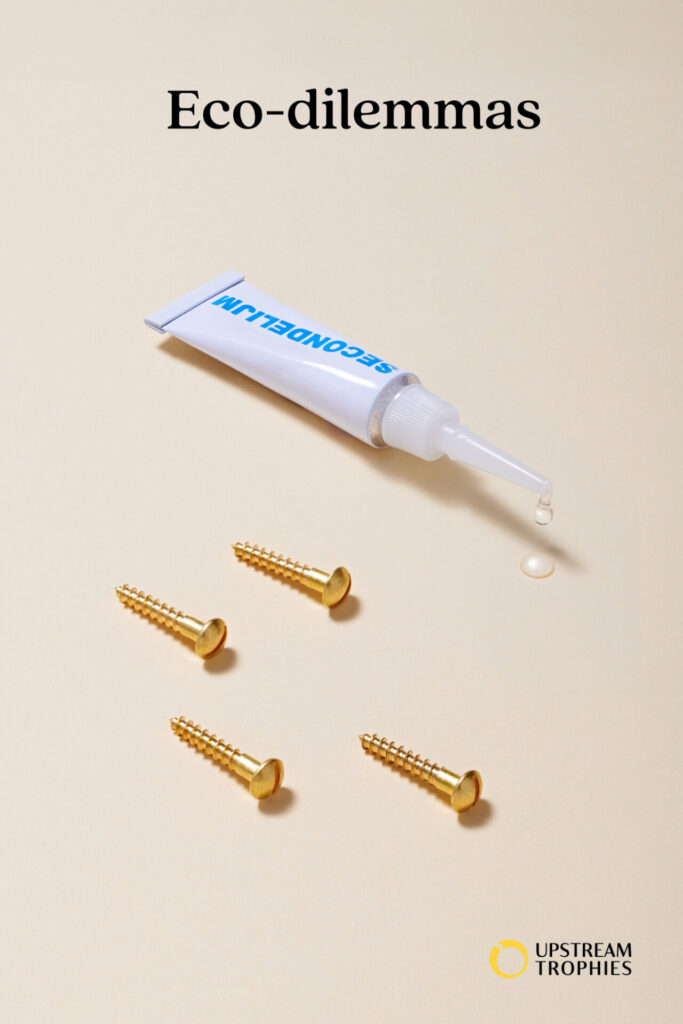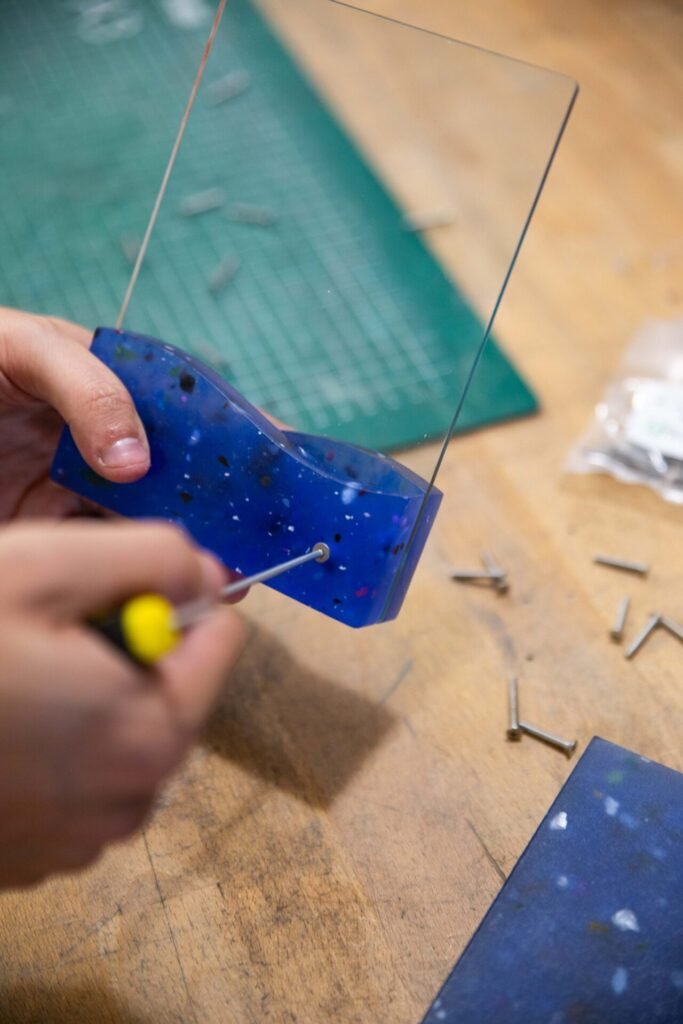Eco-dilemmas
Welcome to Eco-dilemmas, our blog series where we explore the challenges we face at Upstream Trophies as we strive to create sustainable, high-quality awards. From designing our trophies to tackling broader issues like sourcing materials, packaging, and transportation, every decision impacts the balance between sustainability, design, and cost.

Using glue or screws
in assembly?
At Upstream Trophies, we are constantly weighing every decision in our production process. Some choices are easier than others. One ongoing dilemma? Screws or glue. Each option has its pros and cons, but the decision isn’t so straightforward. In this blog we look at the differences between screws and glue and why we believe one option is better suited for the future of award design.
A small choice with a big impact on circularity
Screws are made from metals, often involving mining and complex processing. Does that mean a high carbon footprint? Yes, but the bigger picture matters. Screws allow for easy disassembly, making recycling far more efficient. Reusability and repairability are key to a circular economy, and screws fit perfectly into that model. Moreover the metal of screws has a very high chance of being recycled.
Glue, on the other hand, has a different story. Adhesives like cyanoacrylate and hot melt glue have a lower initial CO2 footprint because they are quicker to produce. However, their impact is felt when making mistakes, updating a trophy and over time. Once fixed, the design is locked in, limiting any potential future improvements or repairs. For products that should last, this is a significant drawback. Glue complicates recycling, it binds materials together in ways that make separation difficult. Most combined materials will end up in incinerators or landfill, not closing the loop. Despite the clean finishes glue offers, its long-term environmental burden is undeniable.
Navigating Design, aesthetics and sustainability in trophy creation
When it comes to design, screws and glue pull in different directions. Screws create an industrial, durable aesthetic. Their strength allows for easy repairs and adjustments, meaning the product can evolve with time. They keep our awards versatile, and while they may slightly limit some sleek design possibilities, the longevity they bring aligns with our sustainability-first approach. Next to this we carefully pick our screws so they go nicely with the design, like a brass screw on a black base, amplifying a premium look and feel.
Glue opens the door to more flexibility. Smooth, sleek finishes and intricate designs are much easier to achieve with glue. But that seamless look comes with a downside: glued parts are difficult to modify. Moreover, specifically for plastics glue is a tricky business. Several kinds of plastics like Polyethylene (PE) or Polypropylene (PP) are very difficult to glue as the materials themselves will not bond with the glue. There are glues available that can but these are often toxic and difficult to work with. Fortunately we’ve found some more sustainable gluing tricks for certain plastics. Limonene is used as a natural solvent in gluing plastics, offering an eco-friendly alternative for bonding materials while maintaining strong adhesive properties. We work a lot with transparent and semi transparent plastics which are often difficult to glue without seeing the actual glue, which looks kind of cheap. Overall we try to avoid glue, as we also had cases that the glue would react with a transparent plastic material days after the application. Leaving ugly white spots behind and ruining a complete series of trophies.
Short-term savings, long-term expenses
The cost factor in this debate is crucial. Screws may be pricier up front. They involve higher material costs and more complicated assembly processes. But the ability to make easy repairs and adjustments is an important factor for the overall production costs.
In contrast, glue reduces production costs due to its quick application and straightforward assembly. Faster production and fewer material restrictions result in a lower upfront cost. However, when working with various plastics, different types of glue are required for specific material combinations. Plastic-specific glues can be particularly expensive, and while we use glue sparingly, open packages tend to dry out and expire. This leads to significant waste and further increases costs, especially when managing multiple types of adhesives.

Conclusion: stick to screws
At Upstream, we choose screws over glue for more than just their durability. Sustainability, flexibility, and long-term value are at the core of our decision. By choosing for screws, we ensure that our awards are built to last. Ready to be reused, repaired, and ultimately recycled. This approach aligns perfectly with our commitment to offer truly sustainable and unique solutions to renew the market of trophies.

Bart Bleijerveld
Technical lead Upstream Trophies
About the author
Bart is responsible for the production of the trophies. He brings the designs to life in sustainable materials. Always looking for new aesthetics, production methods and materials.
Stay ahead with the latest news by subscribing to our newsletter

